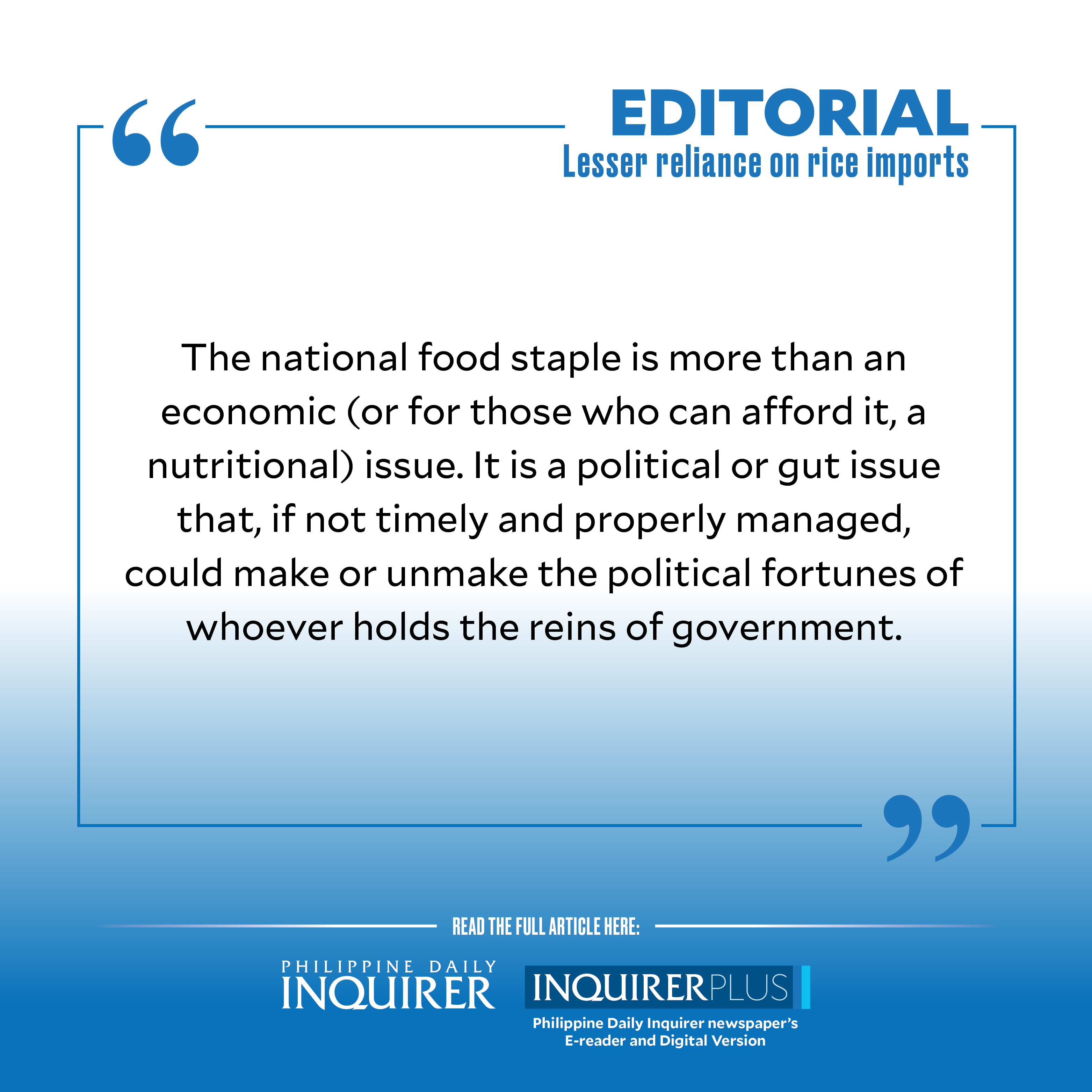Lesser reliance on rice imports

To minimize the adverse effects of the El Niño phenomenon on the country’s rice production, the Department of Agriculture (DA) announced last week that some 500,000 metric tons (MT) of rice from Taiwan and India will arrive in the Philippines this month and in February.
Based on data from the Bureau of Plant Industry, as of Dec. 14 last year, the country imported 3.22 million MT of rice. The bulk of that importation, or 2.8 million MT, came from Vietnam, and the rest was sourced from India and other countries.
The government resorts to rice importation due to the inability of local farmers to meet domestic demand that, according to the DA, is approximately 36,000 MT per day or 1.08 million MT a month.
Without that supply from foreign sources, the price of rice here could reach a level that majority of Filipinos, especially those in the D and E sectors, may not be able to afford.
Note that whenever the price of rice goes up, that spike tends to also influence other basic commodities. And the inflation rate follows suit.
A political or gut issueRice is food that Filipinos cannot do without in their daily life. Its filling effect in the stomach makes up for the scarcity of other food items that usually accompany daily meals.
The national food staple is more than an economic (or for those who can afford it, a nutritional) issue. It is a political or gut issue that, if not timely and properly managed, could make or unmake the political fortunes of whoever holds the reins of government.
In times past, photos of people waiting in line for hours to be able to buy less expensive rice or rushing delivery trucks before their rice cargo can be unloaded influenced the results of national elections.
It was therefore prudent for the government to import rice ahead of the expected shortage of the local produce due to El Niño and the strong typhoons that hit the country last year that destroyed hectares of almost ready-to-harvest rice seedlings.
It takes eight to 12 months from the time the order is made for imported rice to be delivered to the Philippines by the exporting countries. The relative ease by which rice had been sourced from Taiwan, Vietnam, and India may be attributed to the Philippines’ good relations with them.
Next time around, however, it may no longer be that easy (even price-wise) in light of the expected demand for that commodity by other countries whose rice production may suffer serious damage from El Niño.
At the end of the day, the law of supply and demand will decide which country gets priority in rice importation and at what cost.
Full rice self-sufficiencyIn the short term, the importation of rice to augment the country’s rice stocks may be considered a deft political and economic move. It would help mitigate public dissatisfaction and bring down the inflation rate at more manageable levels.
But that action should not evolve as a national policy or be looked at as the go-to solution in meeting the country’s rice requirements which are expected to increase with the growth of our population, which, to date, is at 117 million and counting.
Although full rice self-sufficiency is a pipe dream (or as some economists say, impractical to aspire for in light of globalization), it is essential that the country be as productive as humanly possible in this economic activity. There is a limit to the amount of foreign exchange the country can spend to pay for rice importations.
Besides, there is no assurance that the usual sources of imported rice would continue to set aside parts of their harvests for export, as India had done several months ago when it restricted the export of their grains to some countries.
Modern farming techniquesGiven these circumstances, it behooves the government to invest more in infrastructure projects and activities that can increase rice production which include the construction of additional irrigation facilities, reduction of the cost of fertilizer, promotion of modern farming techniques, and maintenance of strategically located warehouses and cold chains.
But the task of lessening dependence on rice importation through increased local production does not rest on the government alone. It needs the participation of the private sector by way of, as pointed out by Sen. Imee Marcos, value-adding, processing, and distribution of rice harvests.
Meantime, let’s refrain from asking our young to sing the song that starts with the words “planting rice is never fun.” It sends the wrong message to the people who stand to be most adversely affected if the country continues to depend on other countries to meet its rice requirements.




















